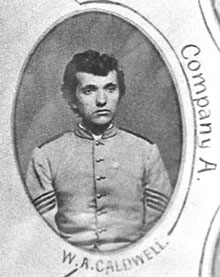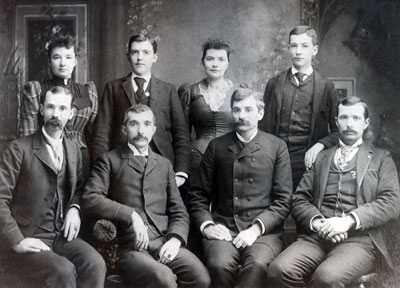 |
|
||||||
|
|
|||||||||||||||||||||||||||||
|
Addison Caldwell: Boy on a mission? by CLARA B. COX M.A. '84
Curiosity or intention? "There is a completely unverified legend that Caldwell's appearance at the college was motivated more by curiosity than by any intention to enroll as a student," Kinnear wrote. "Certainly he had not been nominated for a state scholarship by his county superintendent of schools, as it sometimes has been asserted. Whatever his real motive may have been, immediately he was given a state scholarship by the faculty and enrolled as the first student in Virginia Agricultural and Mechanical College." Anyone who has traced Caldwell's path to Blacksburg by participating in the Caldwell March, a trek by the corps of cadets that breaks the first student's walk to campus into two 13-mile stretches, one in the fall and one in the spring, would argue that a 26-mile hike is a lot of energy to invest in mere curiosity. And records in the Library of Virginia provide a strong argument against Kinnear's conclusion that Caldwell did not have a scholarship before arriving in Blacksburg. On Dec. 6, 1872, Virginia Gov. Gilbert C. Walker instructed the Committee on Public Instruction to ascertain from VAMC President Charles L.C. Minor the number of students, the date of matriculation, and the counties from which they were appointed. He also requested information on the number of students whose expenses were not defrayed by the state. Minor complied on Jan. 8, 1873. In his report, Minor noted scholarship status beside the name of each student, with two scholarships identified. An "A" designation meant that the student was a county school board appointee, and a "B" identified a student "enjoying the same privileges by appointment of the faculty under authorization of the executive committee of the board of visitors." A "C" indicated a student paying his own tuition. An "A" follows Caldwell's name. With scholarship in hand, it is more likely that he made the long walk from Craig County with the sole purpose of registering as a student. Was he the first? Some people question whether Caldwell actually was the first student to register, a question made difficult to answer because the university's records burned in the early 1900s. Support for Caldwell's place in Virginia Tech history can be found in Minor's 1873 report, which records students by day of matriculation and not by alphabetical order. The first name on the list for Oct. 1 is that of William Addison Caldwell. An oral tradition also exists in Craig County that he was the first student, according to county historian Jane Johnston.
Born on Jan. 10, 1856, Add Caldwell grew up on a farm in the Sinking Creek community of Craig County, the second of nine children. When he was 16, he and his older brother, 18-year-old Milton M. "Mic" Caldwell, left their home and walked to Blacksburg, according to Mic's daughter, the late Katherine Caldwell Mendez. Mic, however, waited until Nov. 2 to register. His name on Minor's list is followed by a "B." Both teenagers, then, had state scholarships, although from different appointments, to apply to the $30 tuition and $10 fees. Another brother, Frank, enrolled in 1874, but neither he nor Mic graduated. Add did, but he took an extra year to complete the three-year program in agriculture, finishing with VAMC's second graduating class. A report card indicates that he excelled in written compositions, military tactics, and farm work; was "satisfactory" or nearly so in French, natural history, and composition and rhetoric; and was "tolerable" or worse in mathematics, chemistry, and bookkeeping. During college, he joined the Maury Literary Society and attained the rank of second sergeant of VAMC's Company B. On graduation day, Aug. 9, 1876, he was elected secretary of the class alumni association. After graduating, he worked as a schoolteacher in Craig County and then as a clerk at Norfolk and Western in Roanoke, Va., where he was described as a well-known and popular employee. He moved to Wilmington, N.C., around 1898 and worked, probably as a salesman, for several large wholesale firms. Sometime before 1910, Caldwell's health declined. Doctors told him that salt air would be good for him, so he secured a job as a clerk at a Wrightsville Beach, N.C., hotel. "I have not been here long enough to tell whether the salt air is going to benefit me or not. I am feeling about the same, no worse, no better," he wrote Mendez on June 15, 1910. A few days later, he sustained a severe head injury when he fainted. He died on June 29, 1910, in a Wilmington hospital. His funeral was held in his mother's home--by then she had moved to Radford, Va.--and he was buried in the family cemetery nearby. Today, the Add Caldwell Lounge in G. Burke Johnston Student Center, the library's e-catalog (known as Addison), a statue, and the Caldwell March remind us that education meant so much to a teenage boy that he hiked 26 miles and struggled through an extra year of classes. In doing so, he forged a path for thousands of students who turn to the state's land-grant institution to acquire the skills and knowledge that can lead to a richer life and better future.
|
|||||||||||||||||||||||||||||
|
|
|||||||||||||||||||||||||||||




